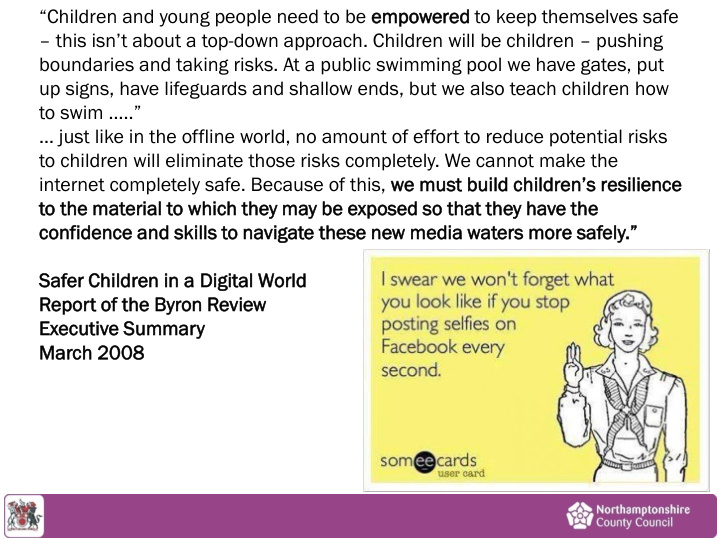



“Children and young people need to be empo mpowered red to keep themselves safe – this isn’t about a top -down approach. Children will be children – pushing boundaries and taking risks. At a public swimming pool we have gates, put up signs, have lifeguards and shallow ends, but we also teach children how to swim …..” … just like in the offline world, no amount of effort to reduce potential risks to children will eliminate those risks completely. We cannot make the internet completely safe. Because of this, we must build children’s resilience to the e materi erial al to which ch they y may be expose osed d so that t they y have e the e confidence and skills to navigate these new media waters more safely.” Safer er Childre dren n in a D Digital tal World rld Repor ort of the e Byron on Revie iew Ex Executiv cutive e Summa ummary March h 2008
1.The first selfie was taken in: a) 2001 b) 1985 c) 1863 2. The average age most parents talk to their children about online safety is: a) 6 b) 9 c) 12 3. 88% of images that go onto social media will end up on other websites without us realising? True or false 4. 1 in 5 11 to 15 year old girls in Northamptonshire have had nudes shared or passed around without consent. True or false 5. On Instagram young people use the acronym ‘tbh’ what does ‘tbh’ stand for? a) To be heard b) To be honest c) To be hated 6. According to young people when is the best time to put a selfie on Instagram to get optimum likes? a) 8am b) 1pm c) 6.30pm
The reality...... The reality........ .... .. 77% of children in Social media is having a Northamptonshire have no limits on massive impact on children's the internet at home friendships and mental health. A third of parents would like 1in4 primary children have seen more information something online that has upset them 70% of parents don't have a say in 88% of young people in this the apps their son or daughter county do not feel at risk online download. 1 in 2 children aged 5 – 11 in every 1 in 5 primary aged children classroom in Northamptonshire say someone has been rude or would go and meet someone they horrible to them online. met on the internet.
Instagram, Musically and Twitter
Offender • Grooming can take, minutes, hours, days or months. • Scatter gun approach. • Identify and exploit the victims vulnerabilities. • Online the offender feels invisible; this invisibility leads to increased courage. • Dissociative anonymity • The offender becomes the person the victim is looking for…… • The offender isolates the victim. • Then increases his control of the victim and the victim does not really realise it. • Blackmail/Threats to disclose personal information and pictures on social networks.
Wa Ways ys to o ke keep s saf afe... .... ...
WWW Approach To an extent, it does not matter where young people go online always remember the basics. We don’t talk to strangers and we do not give out personal information!
Questions Twitter: NCCcybersafe
Resources • Think u know • SWGFL Resources • Parent Zone – scroll to the bottom of the page link to parenting magazine • Internet Matters • Childnet International – resources • NCC e-safety go/search 1 st and 2 nd link • Parent booklet • Youtube for kids app • Swiggle – search engine • Google game console then parental controls UK e.g. Playstation + parental controls UK • UK Safer Internet Centre • Share Aware – Net Aware
Recommend
More recommend